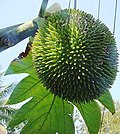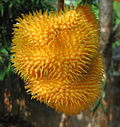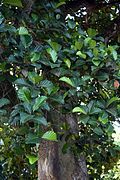| Subgenus | Image | Scientific name | Common name | Distribution |
|---|
| Artocarpus |  | Artocarpus altilis (Parkinson) Fosberg | Breadfruit, Seedless breadfruit, Sukun, Kolo, Rimas, Anubing | Oceania from New Guinea through the Indo-Malayan Archipelago to western Micronesia |
|---|
 | Artocarpus anisophyllus Miq. | Popwan, Entawak, Mentawa | Palawan (Philippines), Peninsular Malaysia, Sumatra, Borneo |
| Artocarpus blancoi (Elmer) Merr. | Antipolo | Philippines (Endemic) |
| Artocarpus brevipedunculatus (F. M. Jarrett) C. C. Berg | | Borneo |
 | Artocarpus camansi Blanco | Breadnut, Kamansi, Kluwih, Deeball, Seeded breadfruit | Philippines, Indonesia, Papua New Guinea |
| Artocarpus corneri Kochummen | | Borneo (Sarawak) |
| Artocarpus chama Buch.-Ham. | Chaplaish | Yunnan China, Bangladesh, Bhutan, India, Laos, Malaysia, Myanmar, Sikkim, Thailand |
 | Artocarpus elasticus Reinw. ex Blume | Benda, Bendo, Teureup, Malagumihan | Burma, Thailand, Peninsular Malaysia, Sumatra, Java, Lesser Sunda Islands, Borneo, Philippines, Sulawesi, Moluccas |
| Artocarpus excelsus Jarrett | | Borneo (Sabah) |
| Artocarpus glaucus Blume | | Indonesia, Malaysia, Australia |
|---|
 | Artocarpus hirsutus Lam. | Anjily, WildJack, Jungle Jack, Angelin, Hirsute Artocarpus, Aini Maram, Aini | Western Ghats, India |
| Artocarpus hispidus Jarrett | | Peninsular Malaysia |
| Artocarpus horridus Jarrett | | Maluku |
| Artocarpus jarrettiae Kochummen | | Borneo (Sabah, Sarawak) |
| Artocarpus kemando Miq. | Pudau, Pudu | Thailand, Peninsular Malaysia, Sumatra, Borneo |
 | Artocarpus lanceifolius Roxb. | Keledang | Indonesia |
| Artocarpus lowii King | | Peninsula Malaysia to Sumatera |
| Artocarpus maingayi King | | Borneo |
| Artocarpus mariannensis Trécul | Dugdug | Mariana Islands and Guam |
| Artocarpus melinoxylus Gagnep. | | Vietnam |
| Artocarpus multifidus Jarrett | | Philippines (Mindanao, Samar) |
 | Artocarpus nobilis Thwaites | Ceylon breadfruit | south western regions of Sri Lanka |
 | Artocarpus odoratissimus Blanco | Johey oak, Terap, Marang, Morangbaum | Borneo, Philippines (Palawan and Mindanao Island) |
| Artocarpus obtusus Jarrett | | Borneo (Sarawak) |
| Artocarpus pinnatisectus Merr. | | Philippines (Luzon, Mindanao) |
| Artocarpus rigidus Blume | Monkey jackfruit | Indochina and Malesia |
| Artocarpus sarawakensis F.M.Jarrett | Pingan, Mountain Terap | Sarawak |
 | Artocarpus scortechinii King | Two winged Artocarpus, Black Terap | Malaysia |
| Artocarpus sepicanus Diels | | New Guinea |
 | Artocarpus sericicarpus F.M.Jarrett | Peluntan, Gumihan, Pedalai, Hairy Terap | Borneo (Sarawak), Malaysia (Sabah), the Philippines (Mindoro), and Indinesia (Kalimantan) |
| Artocarpus sumatranus Jarrett | | Sumatra |
 | Artocarpus tamaran Becc. | Elephant Jack, Tamaran | Borneo |
| Artocarpus teysmannii Miq. | | Nicobar Islands, Peninsula Thailand to W. New Guinea |
| Artocarpus treculianus Elmer | Tipuho, Pakak, Kabaya, Togop, Tugup | Batanes (Philippines) |
| Cauliflori(F.M. Jarrett) Zerega, Supardi, and Motley | | Artocarpus annulatus Jarrett | | Borneo (Sarawak) |
|---|
 | Artocarpus heterophyllus Lam. | Nangka, Langka, Jackfruit | India, South East of Indian Subcontinent, China, Philippines |
 | Artocarpus integer (Thunb.) Merr. | Cempedak, Badak | southeast Asia, especially from Malaysia and can be found in Indonesia to the island of New Guinea, Palawan, Philippines |
| PseudojacaTrécul | | Artocarpus albobrunneus Berg | | Borneo (Kalimantan) |
|---|
| Artocarpus altissimus (Miq.) J. J. Smith | | Peninsula Thailand, Sumatra, Borneo (Kalimantan) |
| Artocarpus borneensis Merr. | Tampang | Borneo |
 | Artocarpus dadah Miq. | Dadah, Tampang | Sumatra |
| Artocarpus fretessii Teysm. & Binnend. | | Eastern Borneo, the Philippines, Sulawesi, the Moluccas and Irian Jaya |
| Artocarpus fulvicortex Jarrett | | Malaya to Sumatera |
 | Artocarpus gomezianus Wall. ex Trécul | Sampang | Assam to W. Malesia |
| Artocarpus gongshanensis S.K.Wu ex C.Y.Wu & S.S.Chang | | NW Yunnan, China |
| Artocarpus griffithii (King) Merr. | Beruni, Selanking | Southern China to Sumatra, Singapore and Borneo |
| Artocarpus humilis Becc. | Beruni, Selanking | Borneo |
| Artocarpus hypargyreus Hance ex Benth. | White Kwai Muk | China |
 | Artocarpus lacucha Buch.-Ham. | Lakoocha, Monkey fruit | Indian Subcontinent and Southeast Asia |
| Artocarpus lamellosus Blanco | Butong | China (Guangdong, Guangxi, Hainan, S Hunan, S Yunnan), Cambodia, Indonesia, Laos, Malaysia, Philippines, Thailand, Vietnam |
| Artocarpus longifolius Becc. | | Borneo |
| Artocarpus nanchuanensis S.S.Chang et al. | | Chongqing (Nanchuan), China |
| Artocarpus nigrifolius C.Y.Wu | | S Yunnan (Jinping), China |
| Artocarpus ovatus Blanco | | Philippines |
| Artocarpus parvus Gagnep. | Kwai muk | South-East Asia, China |
| Artocarpus petelotii Gagnepain | | China (SE Yunnan), N Vietnam |
| Artocarpus pithecogallus C.Y.Wu | | China (Xishuangbanna, Yunnan) |
| Artocarpus primackiana Kochummen | | Borneo (Sabah, Sarawak) |
| Artocarpus reticulatus Miq. | | Sulawesi to Maluku |
| Artocarpus rubrovenia Warb. | Kalulot | Philippines |
| Artocarpus subrotundifolius Elmer | | Philippines |
| Artocarpus styracifolius Pierre | | China (Guangdong, Guangxi, Hainan, SW Hunan, SE Yunnan), Laos, Vietnam |
| Artocarpus thailandicus C.C.Berg | | N Thailand |
| Artocarpus tomentosulus Jarrett | | NE Borneo |
| Artocarpus tonkinensis A.Chev. ex Gagnep. | | China (Fujian, Guangdong, Guangxi, Guizhou, Hainan, S Yunnan), Cambodia, N Vietnam |
| Artocarpus vrieseanus Miq. | | Sulawesi to New Guinea |
| Artocarpus xanthocarpus Merr. | | Taiwan (Lan Yu), Indonesia (Kalimantan), Philippines |
|


















